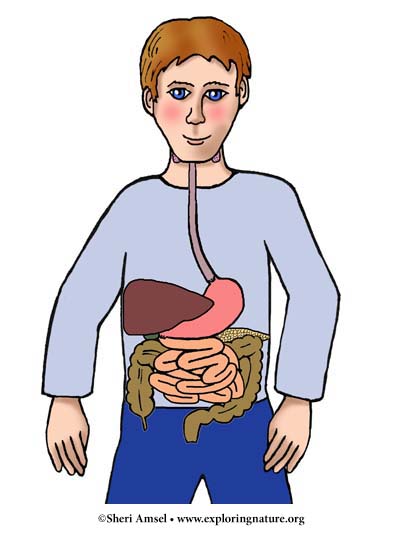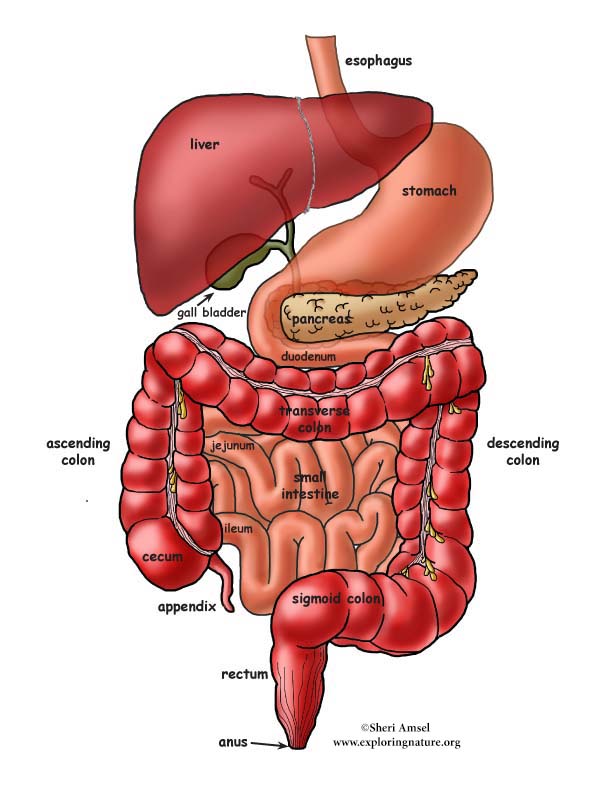

The Internal Organs: From several different body systems (digestive, respiratory and circulatory), the internal organs run the machine that is your body.
The Heart: Your heart never stops beating because it is pumping blood around your body day and night. This is very important, because your blood carries oxygen to all the organs and tissues of your body. The body's tissues need to have oxygen every minute to survive. The blood picks up oxygen that is breathed into the lungs (inhaled) and delivers it by long tubes (blood vessels called arteries) to every tissue of the body. At the same time the blood picks up the waste – carbon dioxide—and delivers it by other long tubes (blood vessels called veins) to the lungs to be gotten rid of when you breathe out (exhaled). The “lub dub” sound of the heart beating is the sound of the heart’s valves opening and closing as the heart squeezes (contracts) and forces the blood on its way. Your heart beat speeds up when you exercise because your muscles need more oxygen, so your heart must work faster to supply it!
The Lungs: The lungs take in (inhale) life-giving oxygen and expel (exhale) carbon dioxide waste. The left lung has two lobes (sections). The right lung has three lobes. Inside the lungs airways get smaller and smaller until they reach the tiny alveoli where oxygen is exchanged for carbon dioxide in the blood.
The Stomach: The stomach is a storage tank for digesting food. Its walls have a lot of muscle in them so it can stretch if you eat a lot of food. It can hold up to a gallon of food. When it is empty, it shrinks back down and its walls fold up. The lining of the stomach has cells that make gastric juice, chemicals that digest food. It has a strong acid that kills bacteria on the foods we eat. It also contains digestive chemicals to digest protein. The stomach churns the food and mixes it with the gastric juices. By the time it leaves the stomach, the food is broken down. Now it is ready to move on to the small intestine.
The Small Intestine: The small intestine is about 6 feet long (2m). It is a hollow tube where digestion is finished up and all the food nutrients are taken off (absorbed) into the blood. It is here that the pancreas gland sends its pancreatic juice into the food. Also bile made in the liver and stored in the gall bladder enters here.
The Large Intestine: The large intestine is about 4.5 feet long (1.5m) and wider than the small intestine. Its job is to take up (absorb) any left over water, vitamins and electrolytes (like sodium and chloride) in the food waste passing through it. Food waste passes through the large intestine (also called the colon) and is passed out of the body.
The Liver and Gall Bladder: The liver and the gall bladder are helper organs of the small intestine. The liver is a large organ, weighing about 3 pounds. It has 4 lobes. The gall bladder is a tiny, green sac about 4 inches long (10 cm). The liver is one of the most important organs of the body. Only a small part of what it does has to do with digestion. It makes bile, which breaks down fat. It also takes the blood coming from the digestive tract and changes all the nutrients into forms the body can use, storing some. It cleans alcohol and drugs from the blood, stores vitamins and reuses the iron in old, worn out red blood cells. The gall bladder stores bile made in the liver.
When you research information you must cite the reference. Citing for websites is different from citing from books, magazines and periodicals. The style of citing shown here is from the MLA Style Citations (Modern Language Association).
When citing a WEBSITE the general format is as follows.
Author Last Name, First Name(s). "Title: Subtitle of Part of Web Page, if appropriate." Title: Subtitle: Section of Page if appropriate. Sponsoring/Publishing Agency, If Given. Additional significant descriptive information. Date of Electronic Publication or other Date, such as Last Updated. Day Month Year of access < URL >.
Amsel, Sheri. "The Organs and What They Do - Lecture" Exploring Nature Educational Resource ©2005-2024. December 14, 2024
< http://exploringnature.org/db/view/The-Organs-and-What-They-Do-Lecture >



